
Content Writer
Tension Force is a type of force experienced when a rope, wire, or string is pulled by forces acting from opposite sides. Tension force is the force that gets transferred when an object is pulled using a rope, wire, or cable.
- Tension Force is directed over the length of the wire and pulls energy equally on both ends.
- Tension forces can also be understood as the opposite of compression.
- They are the action-reaction forces affecting the two ends of a body on which an external force of pull is applied.
- Stress, Tensity, or Tautness are some commonly used terms to describe Tension Forces.
Read More: NCERT Solutions For Class 11 Physics Laws of Motion
Key Terms: Tension Force, Force, Tension, Axial Force, Pulling Force, Mass, Acceleration, Gravitational Force, Tension Force Formula
What is Tension Force?
[Click Here for Sample Questions]
Tension Force is defined as a force generated in the opposite direction to the axial force experienced by an object.
- It is a type of force transmitted through a rope, string, or wire when pulled by forces acting from the opposite side.
- Tension force in a rope allows transferring force through the rope or wire to lift the object.
- Tension force is classified as a type of contact force.
- They can only act in a direction parallel to the length of the flexible medium.
- Tension forces also enable change in the direction in which the force is applied.
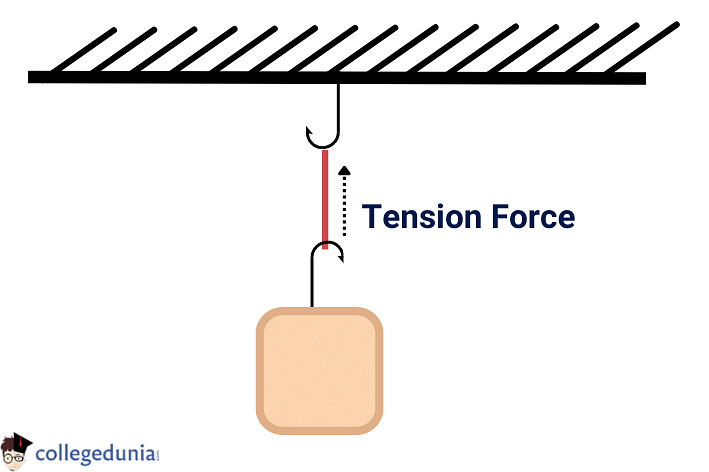
Tension Force
Tsnion Force Example: When water is drawn from a well using a string, the force is applied axially on the string. The tension force acts in the opposite direction causing the string to stretch.
Read More:
Tension Force Properties
[Click Here for Previous Years' Questions]
Here are some important properties of Tension Force:
- When the load is put on one or more materials directionally, the tension force is given as a pulling force.
- The load placed on the material should be applied axially to be a tension force.
- Cables and ropes are used to apply the forces as they can transfer a force over a specific distance at a specific place.
- Tension is a pulling force since ropes cannot push effectively.
- Pushing with a rope causes the rope to go limp and lose the tension that allowed it to pull in the original place.
- Tension forces can hence only be experienced in the pulling off of an object.
- When the rope is massless, it transfers the force from one end to the other very perfectly.
Laws of Motion Detailed Video Explanation
Tension Force Formula
[Click Here for Sample Questions]
Tension Formula is used to calculate the tension generated in the body or object. Tension Force Formula is given as:
| T = mg + ma |
Where
- T denotes Tension Force (N)
- m denotes Mass (kg)
- g denotes Gravitational Force (9.8 m/s2)
- A denotes Acceleration (m/s2)
Solved ExampleExample: An object with a mass of 4 kg is hanging at the end of a rope. Find the tension in the rope if the acceleration of the mass is acting as 7m/s2 in the upward direction. Solution: Given that,
Thus, W = mg W = 4 × 9.8 = 39.2 N Since the acceleration is in the upward direction, it will be positive. Thus, Using the Tension Force Formula, we get T = mg + ma T = 39.2 + 4×7 T = 39.2 + 28 = 67.2 N Thus, the tension in the rope will be 67.2 N. |
Tension Force Examples
[Click Here for Previous Years' Questions]
Tension Force can be observed commonly in various applications in day-to-day life. Here are some common examples of Tension Force:
Towing a Car
- When a car stops working or breaks down in the middle of a road, a tow truck is called for.
- The tow truck is another vehicle that has a hook connected to a length of strong steel cable.
- The hook is then attached to the broken-down car, and then the truck is driven.
- The taut chain or hook in the truck transfers the tension force to the attached vehicle.
- To maximize the transfer of power, the chains and the wires used in the towing mechanism have zero mass.
- The engine of the towing vehicle supplies energy to an arrangement of chains.
- This energy is then coupled to the vehicle that is to be used to tow, thereby allowing the operator to tow the vehicle.
Tug of War
- An elongated or stretched rope is used for the game of tug of war.
- Pulling forces are applied on the rope from both ends.
- This creates tension on the rope and if the force applied at both ends is balanced more tension force gets generated.
- In the case of unbalanced forces, the team that applies the greater pulling force, wins the game.
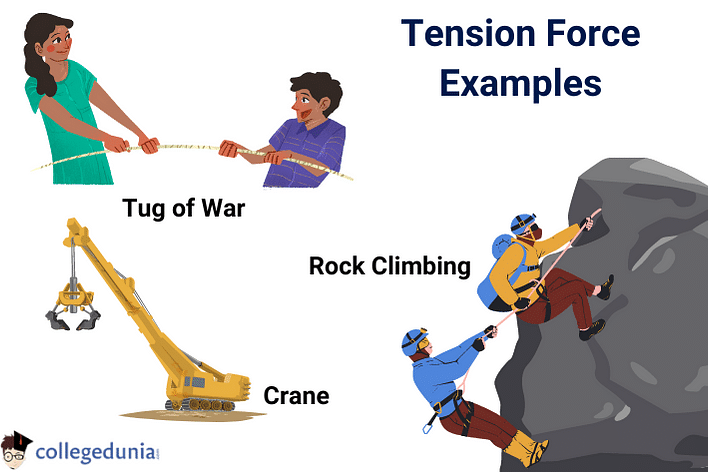
Tension Force Examples
Read More: Laws of Motion Class 11 Important Questions
Rock Climbing
- Rope and pulley arrangements are used by climbers to get to the top of mountains.
- While climbing, the mountaineer fixes the rope on the carabiner.
- The weight of the climber acts as a downward force.
- A pulling force from the carabiner acts in the upwards direction creating a tension force.
Pulling a Rope
- Pushing a rope will cause it to slack or loosen.
- When we pull a rope, tension builds on the elongated part of the rope, this is the pulling force or the tension.
- The force acts along the length of the wire.
Swings in Playgrounds
- When a child swings, a downward pull force acts on the cable.
- The pivots, however, exert a force in the upward direction.
- The seat and the pivot elongate the cable generating a tension force that supports the cable during the swinging motion.
Read More: Laws of Motion MCQs
Uses of Tension Force
[Click Here for Sample Questions]
Tension Force is applicable in the given situations and objects:
- It is used in a crane machine to pick lighter objects.
- It is used for towing cars/vehicles on a busy highway or road.
- Tension Forces are used in weighing balances.
- They are also used for various equipment in the gym.
- Pulling water from a well is one of the most common applications of Tension Force.
- Tension Forces are used in the “tug of war” game.
Check More:
Laws of Motion Class 11 Handwritten Notes
[Click Here for Previous Years' Questions]
Here are the handwritten notes covering the important concepts of the Laws of Motion:
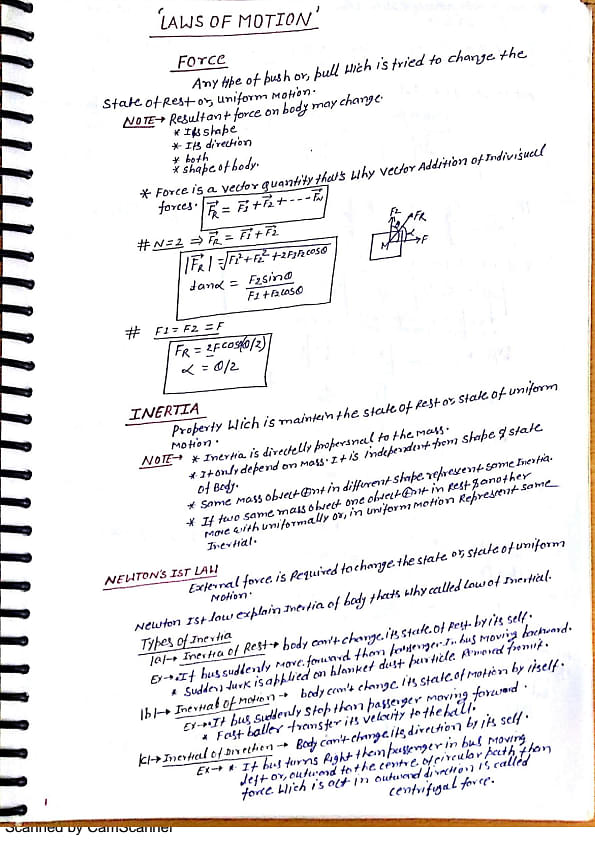
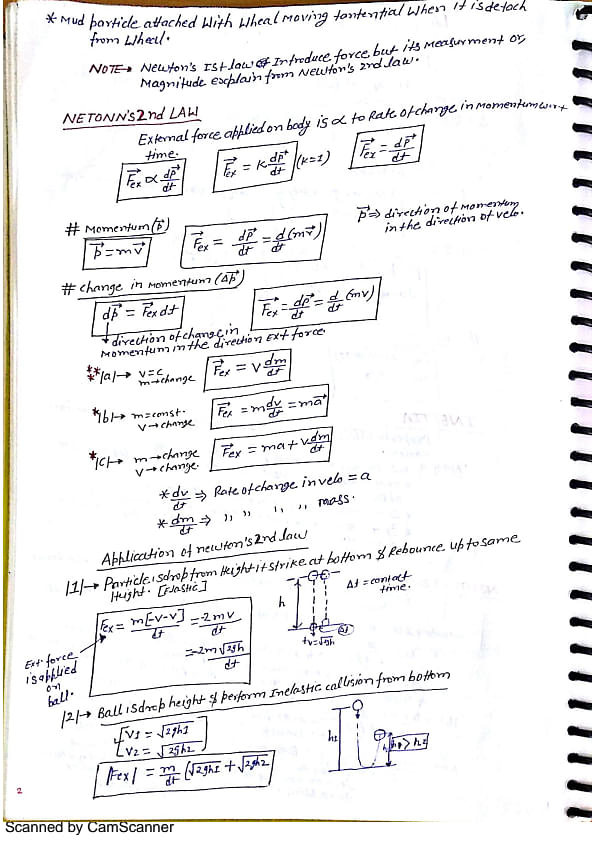

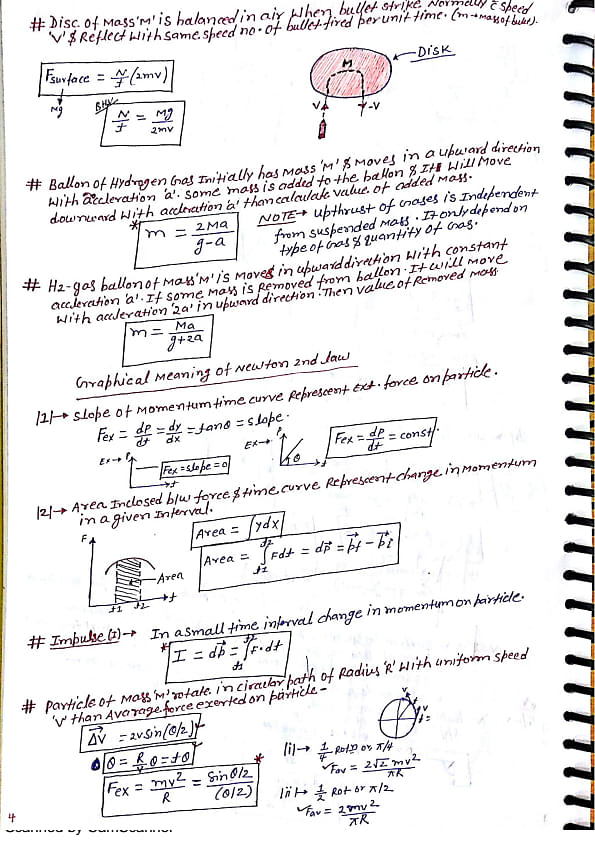








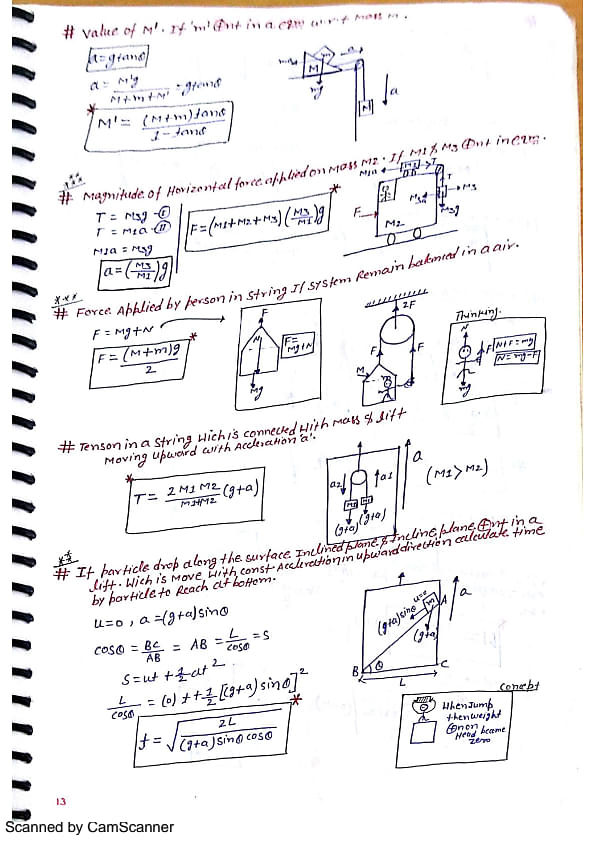


Things to Remember
- Tension Force is a force developed in a rope, string, or cable when stretched under an applied force.
- It is a pulling force that acts along the length of the wire and is equal and opposite to the applied force.
- It is classified as a contact force that passes through a flexible medium.
- Tension Force is generated when force is exerted axially on an object.
- Tension Force Formula is given as T = mg + ma.
- Pulling a rope in a well, tug of war, towing cars or vehicles, etc. are some common examples of tension forces.
Previous Years’ Questions
- A block of mass 5 kg resting on a horizontal surface is connected by a cord... (KEAM – 2019)
- A bob is hanging over a pulley inside a car through, a string. The second... (BITSAT – 2013)
- A block of mass 10 kg is in contact against the inner wall of a hollow cylindrical... (NEET – 2019)
- Which one of the following statements is incorrect... (NEET – 2018)
- A block rests on a rough inclined plane making an angle of... (KCET – 2018)
- An object with mass 5 kg is acted upon by a force... (KCET – 2019)
- A block of mass 10 kg, initially at rest, makes a downward motion on… (TS EAMCET – 2019)
- Figure represents the position-time graph of a body of mass... (AMUEEE – 2018)
- A body of mass 2kg slides down with an acceleration of... (JEE Main – 2018)
- A disc rotates about its axis of symmetry in a horizontal plane at a steady... (JEE Main – 2018)
Sample Questions
Ques. What is Tension Force? (3 Marks)
Ans. Tension Force is a force experienced by a rope, string, or cable when it is pulled from the opposite end.
- Tension Force acts along the length of the wire or cable and is equal and opposite to the applied force.
- Thus, the tension force balances the applied force.
- Tension force is a type of contact force that passes through a flexible medium.
- It is transmitted through a rope or cable only when it is pulled.
Ques. What is Tension Force Formula? (2 Marks)
Ans. Tension Force Formula is given as follows:
T = mg + ma
Here,
- T: Tension
- m: Mass of Object
- g: Gravitational Force
- a: Acceleration
Ques. An 8 Kg mass is dangling at the end of a thread. If the acceleration of the mass is acting as 1.5 m/s2 in the upward direction, what will be the tension created? (3 Marks)
Ans. Given Parameters are:
- m = 8 kg
- a = 1.5 m/s2
- g = 9.8m/s2
Using the Tension Force Formula, we get
T = mg + ma
T = 8 × 9.8 + 8 × 1.5 = 90.4 N
Thus, the tension force acting on the mass is 90.4 N.
Ques. State a few examples of Tension Force. (3 Marks)
Ans. The common examples of Tension Force are as follows:
- Object Suspended by a Pulley
- Suspension of Pendulum Bob
- Swing in a Playground
- Elevator Suspended by Cable
- Suspension Bridge
- Seat Belts
- Tug of War Game
- Towing of Vehicles
Ques. What is the work done by a Tension Force? (2 Marks)
Ans. Work is defined by force and displacement. Tension is a resultant force that does not bring about any displacement.
Work is given as W = FS, where F is the force and S is the displacement.
In the case of Tension Forces, S = 0.
Therefore, W = F x 0= 0
Therefore, the work done by a tension force is always zero.
Ques. What is the direction of a Tension Force? (2 Marks)
Ans. Tension Forces are pulling forces. When a rope is pulled, the tension forces will act away from the object in the direction of the pull. Similarly, for a hanging object, the tension force would act in the upwards direction as the string is pulled upwards to make it hang.
Ques. A bird of mass 500 g climbs up a light vertical string suspended from a hook with an acceleration of 9 m/s2. What will be the tension created on the string? (3 Marks)
Ans. Given parameters are:
- m = 500 g = 0.5 kg
- a = 9m/s2
- g = 9.8 m/s2
Using the Tension Force Formula, we get
T = mg + ma
T = (0.5×9.8) + (0.5×9)
T = 4.9 + 4.5 = 9.4 N
Thus, the tension on the string will be 9.4 N.
Ques. What is the effect of gravity on the Tension Force? (2 Marks)
Ans. Tension force is always directed in the opposite direction to that of the gravitational force. Hence, when an object hangs, the tension force balances the gravitational pull of that the object does not accelerate downwards.
Ques. What is Force? (3 Marks)
Ans. Force is defined as a push or pull of an object.
- Force is a physical quantity that helps to describe the influence of one object on another, causing it to accelerate or deform.
- It is a vector quantity that has both magnitude and direction.
- Force is measured in Newtons (N), which is defined as the amount of force required to accelerate a mass of one kilogram by one meter per second squared.
Ques. How Pulling a Bucket of Water from a Well is considered an example of Tension Force? (2 Marks)
Ans. Pulling a Bucket of Water from a Well is considered one of the most common examples and applications of tension forces. One end of the rope is used and tied to the handle of the bucket, while the other end is tied to the pulley. When this type of rope or cable is stretched by an external force, tension builds up. The rope becomes a medium to transfer energy between the bucket and the person who is trying to pull the water out of the well. In this manner, the person is able to pull up the water from the well.
Check-Out:






Comments